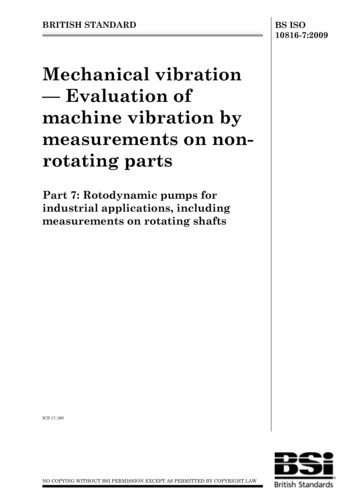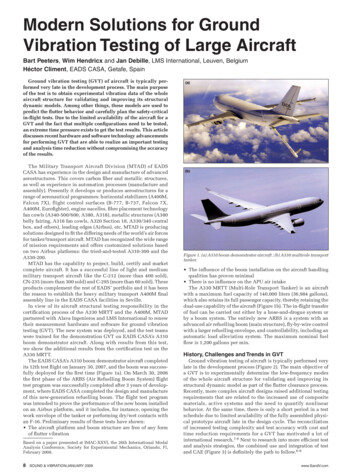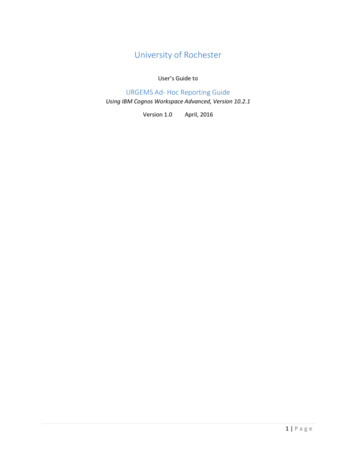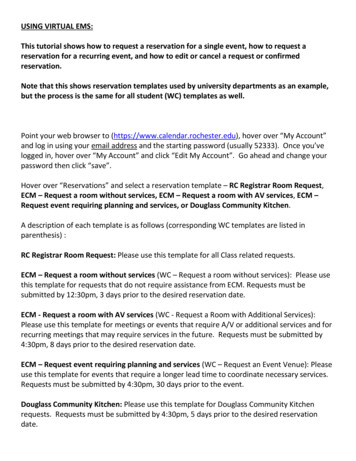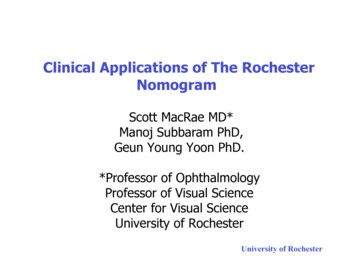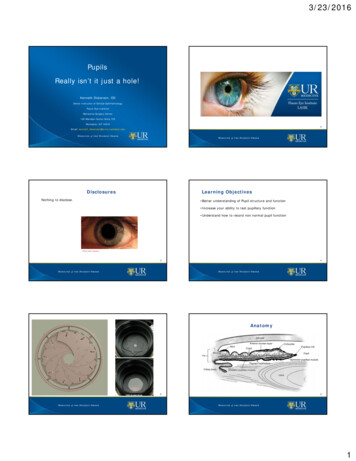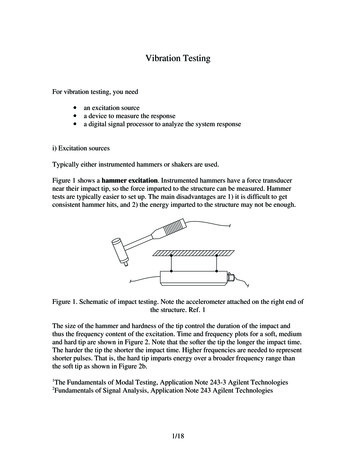
Transcription
Vibration TestingFor vibration testing, you need an excitation sourcea device to measure the responsea digital signal processor to analyze the system responsei) Excitation sourcesTypically either instrumented hammers or shakers are used.Figure 1 shows a hammer excitation. Instrumented hammers have a force transducernear their impact tip, so the force imparted to the structure can be measured. Hammertests are typically easier to set up. The main disadvantages are 1) it is difficult to getconsistent hammer hits, and 2) the energy imparted to the structure may not be enough.Figure 1. Schematic of impact testing. Note the accelerometer attached on the right end ofthe structure. Ref. 1The size of the hammer and hardness of the tip control the duration of the impact andthus the frequency content of the excitation. Time and frequency plots for a soft, mediumand hard tip are shown in Figure 2. Note that the softer the tip the longer the impact time.The harder the tip the shorter the impact time. Higher frequencies are needed to representshorter pulses. That is, the hard tip imparts energy over a broader frequency range thanthe soft tip as shown in Figure 2b.12The Fundamentals of Modal Testing, Application Note 243-3 Agilent TechnologiesFundamentals of Signal Analysis, Application Note 243 Agilent Technologies1/18
350mHard50.0m/DivMediumRealSoftvPulset-50.0m16 msFigure 2a. Measured force versus time comparing soft, medium, and hard hammer tips.Ref. 1-50.010.0/DivHardMediumdBSoftrmsv2-130Fxd X0Hz2.5k2.5 kHzFigure 2a. Measured force versus frequency comparing soft, medium, and hard hammertips. These plots are obtained by taking the Fourier Transform of the curves in Figure 2a.Ref. 1This is a good example for thinking about the frequency content of a forcing function.2/18
Figure 3 shows a shaker excitation. A controller is needed to control the motion of theshaker. A variety of signals can be created, including 1) single frequencies, 2) a chirp orsine sweep, and 3) random vibration. A rod or wire, called a “stinger” is often used toconnect the shaker output to the structure. Often, a force transducer is put between theshaker and the structure, so the excitation force can be iterFigure 3. Schematic of test configuration with a shaker as the exciter. Ref. 1ii) Accelerometers, as shown in Figure 1 and 3, are typically used to measure theresponse of a system. A basic accelerometer measures the acceleration in one direction.Triaxial accelerometers exist to measure accelerations in 3 perpendicular directionssimultaneously. Accelerometers are chosen based on the frequency range of interest andtheir size. If the mass of the accelerometer is on the order of the mass of the structure, itwill affect the vibration. A non-contact device such as a laser vibrometer, capacitanceprobe, or eddy-current probe, can be used instead to measure the displacement.iii) A digital signal analyzer is needed to control the shaker and to transform theaccelerometer and force transducer data into the frequency space.3/18
Measurements are typically plotted in the frequency domain (Discrete Fourier Transformof the time domain signal) because time domain signals are typically complicated and uninformativeknowledge of the response to harmonic excitation is needed to characterizethe structure --- i.e. obtain information about the natural frequencies andmode shapesknowledge of the response to harmonic excitation is needed to understand theresponse to more general loading (which can be very complicated).signals important for machine fault diagnosis are easier to identify in thefrequency domain.Because the frequency domain in so important in vibration measurement, we will nextdiscuss the frequency domain representation to a number of signals measured as afunction of time. First, look at the time domain signal in figure 4b that consists of 2 sinewaves of different frequencies summed together. The 2 sine waves are shown in thelower half of Figure 4b, while the sum is shown as the solid curve above these two sinecurves. In Figure 4a, the 2 sine curves are shown in a 3-D plot, with frequency as the 3rdaxis. Finally, the plot in Figure 4c is obtained by rotating this 3-D plot. In other words,the time signal consists of 2 frequencies, which are represented as 2 spikes in thefrequency domain.Figure 4. Time and frequency domain representations of a signal obtained by summing 2sine waves of different frequencies. Ref. 24/18
As another example, consider the response of a 1-degree-of-freedom system shownschematically in Figure 5 to an arbitrary load f(t). We know the response to a timeharmonic excitation can be represented as a plot of amplitude and phase versus forcingfrequency as in Figure 7. Note that the frequency domain plot has a peak near the naturalfrequency. The width of this peak depends on the damping. Recall that we can measurethe damping of this 1-degree-of-freedom system from the Quality Factor – which isrelated to the width of this peak. The more damping the wider the peak.If the system is driven at a constant frequency, then each point on the curve is equal tothe amplitude of the steady state response at that frequency divided by the amplitude ofthe force. In vibration testing, the plots in Figure 7 can be obtained by dividing theFourier transform of the response by the Fourier transform of the forcing function for anyforcing function. The plots in Figure 7 are thus often called the transfer function.Damper cSpring kResponseDisplacement (x)Mass mExcitationForce (f)Figure 5. 1-degree-of-freedom system. Ref. 15/18
MagnitudeH(ω) 1/m(ωn2 -ω2)2 (2ζωωn ) 2Phaseωdθ(ω) tan-12ξωωnωn2 -ω2ωdFigure 7. Frequency domain response (amplitude and phase) of a1-degree-of-freedomsystem to a harmonic loading. Also, transfer function for a1-degree-of-freedom systemobtained from an impact loading by dividing the Fourier transform of the response by theFourier transform of the force. Ref. 16/18
The response of the one-degree-of-freedom system to a sharp hammer impact is shown inFigure 7. The response is a damped oscillation at the damped natural frequency ω d . If wetake the Fourier transform of the response to a hammer hit and divide by the Fouriertransform of the hammer force versus time function, then we should obtain the transferfunction in Figure 6.e -σ tωdFigure 6. Time domain response of a1-degree-of-freedom system to an impact. Ref. 17/18
As another example, consider the response of a 3-degree-of-freedom system shownschematically in Figure 8 to a hammer impact. The response, shown in Figure 9, consistsof the sum of 3 damped sinusoids. As you can see, it is difficult to make sense of thistime domain plot. However, the response is much easier to understand in the ure 8. 3-degree-of-freedom system. Ref. 10.0Sec6.0Figure 9. Time domain response of a3-degree-of-freedom system to an impact. Ref. 1The transfer function in Figure 10a for the 3-degree-of-freedom system has 3 peaks at the3 natural frequencies. If these peaks are well separated, they can be treated similar to thesole peak of the 1-degree-of-freedom system. Damping of each mode can be obtainedfrom the width of each peak. However, if the peaks overlap, then more sophisticatedmethods are needed to obtain this information. Figure 10b illustrates the 3 curves, one ateach frequency, that are summed to obtain the transfer function of Figure 10a.8/18
dB Magnitudeφi φj /mnΗ(ω) Σr 1(ω n - ω2)2 (2ξωωn ) 220.0ω1ω3ω2FrequencyFigure 10a. Frequency domain response of a 3-degree-of-freedom system to a harmonicloading. Also, transfer function for a3-degree-of-freedom system obtained from animpact loading by dividing the Fourier transform of the response by the Fourier transformof the force. Ref. 1Mode 1Mode 3dB MagnitudeMode 20.0ω1ω3ω2FrequencyFigure 10b. Individual mode contributions to the 3-degree-of-freedom transfer functionshown in Figure 10a. Ref. 1Measurement Accuracy is affected by a variety of factors. To obtain better accuracy Minimize extraneous noise – (electronic, acoustic, floor vibrations, etc.)Average over a number of data sets to reduce random noiseUse a source with sufficient energy input, but keep in the linear rangeChoose an appropriate sampling rate (at least 2X the highest frequency)Band-pass filter to prevent aliasingWindow to avoid errors due to the discrete Fourier transformChoose an appropriate input range to match the signal amplitude9/18
THE DISCRETE FOURIER TRANSFORMAll real measurements are discrete sampling of an analog signal, so you must be aware ofhow this descritization can affect the results. Typically you will choose a constantsampling rate defined by T , the time between samples, and the number of samples N .The total sampling time will therefore be Tmax N T . The maximum frequency that canbe distinguished fmax and the frequency resolution f will be determined by your timedomain sampling. This is shown pictorially in Figure 11.If we define t o 0, then the Nth and last data point occurs at t N 1 ( N 1) t . Because thediscrete Fourier transform assumes periodic signals with period Tmax , p(Tmax ) p(0) . Sothe time domain function is discretized into N points asp( t ) { p(0), p( t ), p(2 t ),L, p(( N 1) t )}.Just as the definition of the Fourier transform differs slightly from book to book, so doesthe definition of the discrete Fourier transform. In the book by Brigham [Ref. 3], thediscrete Fourier transform is defined as n N 1 i 2 πnk / NP , p( k t )e N t k 0n 0,1, 2,L, N 1,(1)and the inverse discrete Fourier transform is defined byp( k t ) N 1 n i 2 πnk / N1P , e N k 0 N t k 0,1, 2,L, N 1.(2)From the definitions, it is apparent that the frequency resolution is f 1 /( N t ) 1 / Tmax .The discrete Fourier transform produces only N/2 independent complex numbers, and thesecond half of the data is just the complex conjugate of the first half, the magnitudesymmetric about the mid-frequency point. Therefore, the maximum frequency occurs atn N/2, that is, f max 1 /(2 t ) . But, if N is even, analogous to the time domain,P ( f max ) P (0) .3The Fast Fourier Transform, E.O. Brigham, Prentice Hall, 1974.10/18
p2p3p1pN popop4pN-1Tmax N t Tto 0 t1t2t3t4tN-1 tNtime P 4 P o P N/2 P 1 P 3 P 2 f 1/ Tmaxfo 0 f1f2f3f4f max fN/212 TfN-1 fNfrequencyFigure 11. Time domain sampling affects maximum frequency and frequency domainresolution.11/18
Here we repeat the two important relationships between the time and frequency domainsampling.MAXIMUM FREQUENCY SAMPLED: fmax FREQUENCY RESOLUTION: f 12 T(3)fmax1 N /2Tmax(4)The first equation is a statement of the Nyquist Criterion – the sampling rate 1/ T mustbe at least twice the highest frequency. That is, there must be at least 2 samples per cycleto identify the frequency correctly.The second equation results from the restriction that there are N /2 complex data points inthe frequency domain corresponding to the N data points in the time domain. These aredemonstrated in Figure11.If there is significant signal at frequencies higher than fmax , the sampling rate will not beadequate to identify the frequency and therefore the high frequency signal will appear tobe at a lower frequency. This is demonstrated for a simple time harmonic signal in Figure12. This is called aliasing. Aliasing can be prevented by filtering out the energy atfrequencies higher than fmax .timeFigure 12. Aliasing – A signal will appear to be of much lower frequency if the samplingrate is not adequate.12/18
If we compare the definition of the discrete Fourier transform to that of the complexFourier series, we can then determine the amplitude of the contribution at each frequency.The complex Fourier series of a periodic function f ( t ) with period T1 2π /Ω1 can bedefined as F ef (t ) ninΩ1 t,where ,n 1Fn T1T1 f (t )e inΩ1 t.(5)0The energy at frequency nΩ1 is equal to Fn F n 2 Fn . So if we approximate theintegral for Fn as a summation of discrete data points, then we obtainFn 1T1T1 f ( t )e in 2 πt / T1 0k tN 1N 1 in 2 π11N tf ( k t )e t f ( k t )e i 2 πnk / N N t k 0N k 0(6)By comparing the definition of the Fourier series in Equation (6) to the definition used inRef. 3 for the discrete Fourier transform in Equation (2), we conclude that the discreteFourier transform amplitude Pn must be multiplied by 2 /N to obtain the contribution atthe frequency n f .Mathematica uses a slightly different definition for the discrete Fourier transform pair.Let {bs} represent the list that is the DFT of the list {ar } , where r, s 1, 2, 3,L, N . Thenthe Mathematica commands relating these two lists are{bs} Fourier[{ar }]and{ar } InverseFourier[{bs}] . (7)and1ar NMathematica’s definitions are1bs NN a er2 πi( r 1)( s 1) / Nr 1N b es 2 πi( r 1)( s 1) / N.(8)r 1The only real difference between the definitions in Equations (1) and (2) and thedefinitions in Equation (8) is that the amplitude of the Mathematica’s DFT is 1/ Ntimes the definition in Brigham’s book. Therefore, we conclude that the discrete Fouriertransform amplitude bs must be multiplied by 2 N / N to obtain the contribution at thefrequency ( s 1) f .13/18
Discrete Fourier transforms assume that the signal is periodic with time period Tmax . Ifthe signal level and slope at the end does not match the signal level and slope at thebeginning, then this effectively will introduce a jump in the signal because of theassumed periodicity of the signal. This is illustrated in Figure 12. Windowing is used toweight the signal at this artificial discontinuity so that it has less of an effect on theFourier transform. However, care must be taken when using windows because they canaffect the Fourier transforms in other ways. A “Uniform” window uses a constant unityweight factor over the entire domain, i.e., it
Because the frequency domain in so important in vibration measurement, we will next discuss the frequency domain representation to a number of signals measured as a function of time. First, look at the time domain signal in figure 4b that consists of 2 sine waves of different frequencies summed together. The 2 sine waves are shown in the lower half of Figure 4b, while the sum is shown as the .
